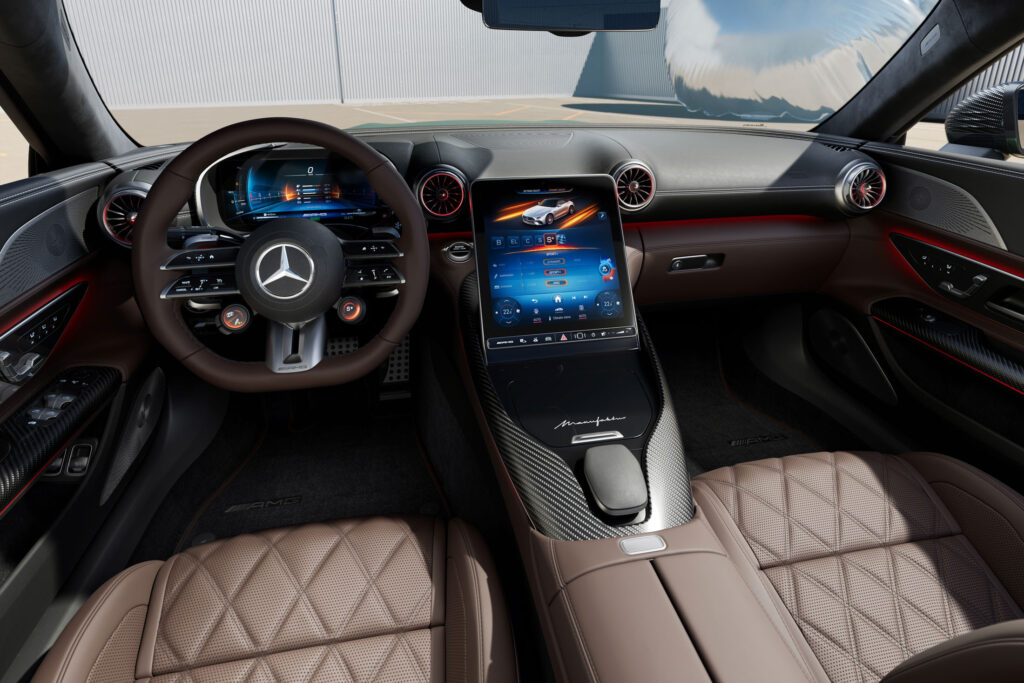AWD roadster mates a front-mounted twin-turbo V8 with an electric motor working on the rear axle, but EV range is just 8 miles
2 hours ago
 –>
–> 
–>
Hear that? It’s the sound of a million sighs of relief from car fans around the world who’ve just learned that Mercedes most powerful SL ever, and the model’s first PHEV, is sticking to its V8 guns. Or maybe it’s the imagined sound of said SL making the kind of burbly eight-cylinder noises we expect a $200k AMG to make.
While the little C 63 sedan downsized to a four-cylinder PHEV setup that’s apparently left critics and buyers unmoved, despite its impressive stats, the upcoming E 63 is rumored to be downgrading to a six-cylinder PHEV, and Merc’s own SL 43 already uses a four-banger, the clunkily-named SL 63 S E Performance keeps the base SL 63’s V8 and adds electric assistance on top.
In fact, the new PHEV’s 4.0-liter V8 makes more power on gasoline alone than the similar V8 in the stock SL 63 does. That straight ICE motor is rated at 577 hp (585 PS) and 590 lb-ft (800 Nm), but the new halo model’s version is bumped up to 604 hp (612 PS) and 627 lb-ft (850 Nm), to which is added 201 hp (204 PS) from the single electric motor acting on the rear axle.
advertisement scroll to continue
Computing total system output isn’t as easy as adding the two figures together, but in the case of the SL 63 S E Performance, it’s not far off. The PHEV generates a solid 805 hp (816 PS) and up to 1,047 lb-ft (1,420 Nm) of torque, which is less than the 832 hp (843 PS) pumped out by the four-door AMG GT S E Performance, but still a hell of a lot of horses.
Related: Mercedes-AMG CEO Shuts Down Rumors About The V8 Returning In The C63 And E63

Fastest production SL yet
Those ponies are shared between all four wheels – yes, even the electric motor’s torque can be fed back through the 4Matic system when rear slip is detected – resulting in a zero to 62 mph (100 kmh) time of 2.9 seconds, down from 3.6 seconds for the regular SL 63. If AMG quoted a 60 mph (97 kmh) figure and subtracted the dragstrip rollout as American automakers and magazines do, you’d probably be looking at close to 2.5 seconds. Top speed? One-ninety-seven (317 kmh). No doubt about it, this is a rapid roadster.
What it isn’t, is a great PHEV, at least not in the conventional sense. Like its C 63 little brother, the SL’s plug-in system has been designed to prioritize performance, meaning the miniscule 6.1 kWh battery delivers an electric driving range of just 8 miles (13 km). Even Ferrari’s 296 GTB can travel twice as far on a full charge. And though our neighbors might be pleased to hear that the powertrain starts silently by defaulting to the electric motor, as the Ferrari’s does, we can’t say we’re as delighted by the news, or the prospect of what seems to be a fake start-up sound being pumped in via the speakers.
Active suspension, active aero
On the plus side, drivers can make use of the electric motor’s braking effect, and adjust that regen strength from almost non-existent to so strong that the car can be driven with one pedal. The chassis features steel springs, adaptive dampers, active anti-roll bars and rear-axle steering, just like the standard SL 63, but the PHEV goes one further in the stopping department with standard carbon-ceramic brakes and bronze-colored calipers.
Another plug-in exclusive is an active front spoiler that’s hidden from view, but extends downwards by 40 mm (1.6 inches) beyond 50 mph (80 kmh) to create a venturi effect and reduce lift on the nose. That’s mated to the existing active trunk-lid spoiler, which Mercedes says has been reprogrammed to suit the PHEV’s extra performance and – un-said, but implied – weight.

More pounds, more dollars
Yeah, about that. Mercedes hasn’t said by how much the electric package inflates the curb weight, or what the overall weight is. But we do know that the ordinary SL 63 already tips the scales at a hefty 4,340 lbs (1,970 kg) and that a similar PHEV conversion on the four-door AMG GT 4 adds a substantial 573 lbs (260 kg) of girth. Sounds like those carbon brakes are going to have their work cut out, as they will when this same hardware is transplanted to the SL’s hardtop cousin, the new AMG GT two-door.
The other thing Mercedes hasn’t yet revealed is the price, though again, we can make an educated guess. An ICE SL 63 costs $183,000 in the US, but the model appears to have been removed from the UK pricelist, suggesting the PHEV will take its place, and we’d expect to pay $200k / £190k when the hybrid lands next spring.

 <!–
<!– –>
–> 